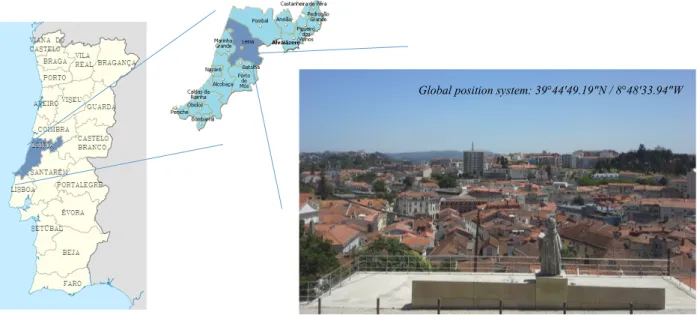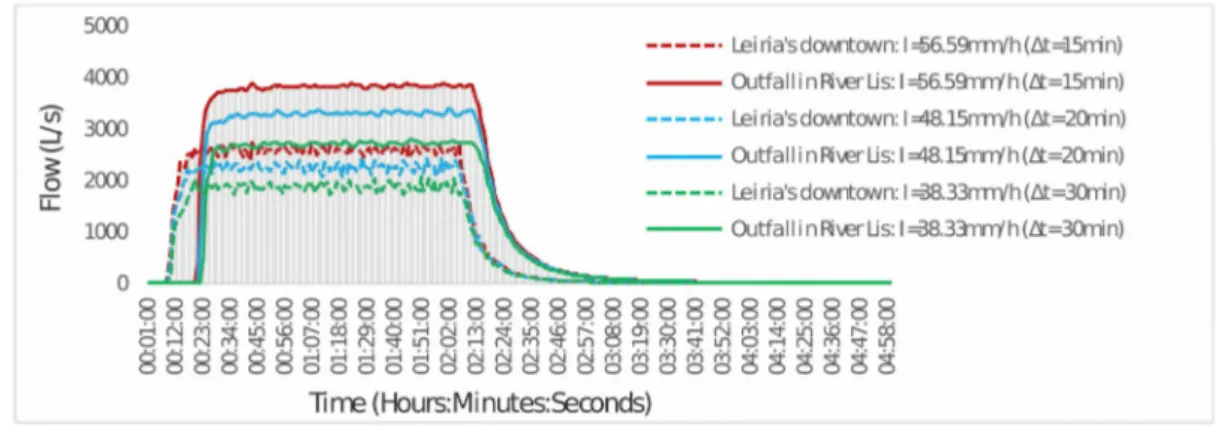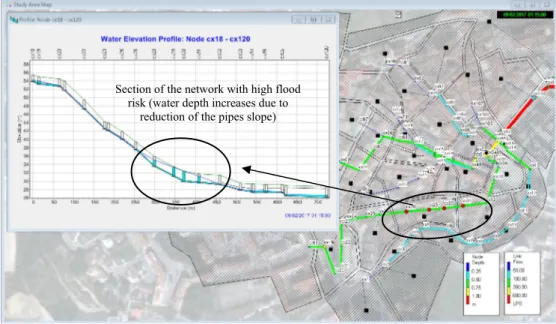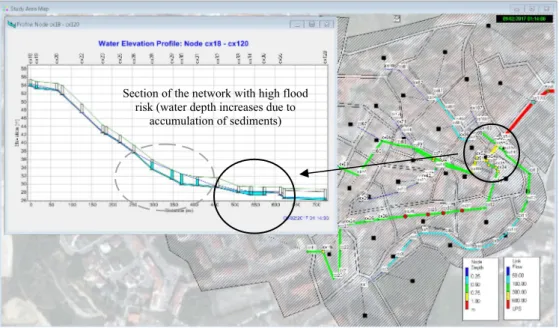Analysis and Simulation of Drainage Capacity of Urban Pipe Network
Gomes, R.1,6, Vellando, P. 2,7, Sousa, J.3,6, Sá Marques, J.4,6, Muranho, J.5,61 Polytechnic Institute of Leiria, School of Technology and Management (Portugal) 2 University of A Coruna, School of Civil Engineering, (Espanha)
3 Polytechnic Institute of Coimbra, Department of Civil Engineering (Portugal) 4 University of Coimbra, Department of Civil Engineering, Coimbra (Portugal) 5 University of Beira Interior, Department of Computer Science, Covilhã (Portugal) 6 MARE - Marine and Environmental Sciences Centre, Faculdade de Ciências e Tecnologia,
Coimbra (Portugal)
7 CITEEC - Centro de Innovación Tecnolóxica en Edificación e Enxeñería Civil, University of A Coruna (Espanha)
1Corresponding author: ricardo.gomes@ipleiria.pt
ABSTRACT
In the last decades the urban area of Leiria (Portugal) has spread quickly and the impervious surfaces increased significantly, mostly because of the type of pavements used (asphalt and Portuguese cobblestone) and the area occupied by buildings. One of the major problems is related to the recurrent floods in Leiria’s downtown during periods of higher rainfall intensity, which affect the economic activities, the environment and the residents’ lives. The urban area benefits from a large drainage network, but in some zones it has low performance, due to the degradation of the infrastructure and the successive located interventions occurred in the last decades (for network expansion and rehabilitation works). To minimize the flooding impacts in Leiria’s downtown, the municipality intends to build an underground pipeline (a length of 1.5 kilometres, with a 2.0 metres diameter and 0.2% slope) to convey the runoff by gravity from Leiria’s downtown to the river. This paper presents an integrated study of the urban catchment and the drainage network capacity using the Storm Water Management Model (SWMM). This study included the analysis of the solution for different rainfall intensities (corresponding to different return periods) to assess its performance and, when required, suggest additional recommendations.
Keywords: SWMM, Urban catchment, Urban drainage networks
1
INTRODUCTION
Urban spaces are particularly vulnerable to flooding, because they have a lot of impervious surfaces [1] and [2]. Thus, when high intensity precipitation occurs, instead of infiltrating in the soil, the rainwater causes an increase in the surface runoff which rapidly accumulates at the lowest points of the urban catchment, causing floods. Obviously, the performance of the drainage networks in these urban areas plays a very important role in the risk of flooding. It is therefore important to have adequate knowledge of the hydraulic behaviour of these infrastructures for expected scenarios. This way, it is possible to identify the most appropriate strategies to improve the performance over their lifetime. These systems consist of a set of underground pipes which convey the rainwater, from the inlets (curbs and gutters) to the final destination (receiving water bodies). Along the drainage network there are several manholes for maintenance operations (flow observation and pipe cleaning) and, sometimes, in large networks, there are complementary devices to improve the infiltration of rainwater and/or control the time lag of the peak flow (manhole infiltration, retention basins). These drainage systems are commonly designed for relatively short return periods (usually less than 10 years), meaning that there is always a risk of flooding, whenever the capacity of the
system is exceeded. It is in the context of the performance of these systems that it is possible to list the causes of floods in urban areas, which may be related to: 1) Obstruction/degradation of pipes, manholes and inlets; 2) Undersizing of pipes and inlets; 3) Increase of impervious surfaces, not expected in the design; 4) Connection of new areas to existing systems; and 5) Increased of extreme weather events. However, for each specific system, only an in-depth study will allow to identify which cause(s) identified above contribute to the occurrence of such floods.
As it is technically/economically infeasible to design a storm water system which will never cause floods (the cost would be prohibitive), the best practices involves establishing a compromise between the cost and an acceptable risk of flooding to be considered in the design. When dealing with existing systems, first it is necessary to understand the overall performance of the network, in order to identify the critical parts of the system and the most appropriate strategies which will improve their performance. EPA's Storm Water Management Model (SWMM) has been used as a tool to support the planning, analysis, and design of storm water systems, combining sanitary sewers and other drainage systems in urban areas [3].
The urban area of Leiria benefits from a large drainage network, but in some zones it has low performance, due to the degradation of the infrastructure and the successive interventions occurred in the last decades (for network expansion and rehabilitation works). One of the major problems is related to the recurrent floods in Leiria’s downtown during periods of higher rainfall intensity, which affect the economic activities, the environment and the residents’ lives. The municipality of Leiria intends to proceed with the renewal of one of the main arteries of the town. Previous studies showed that the drainage network in that area has low performance and is one of the main causes for occurring floods in the Leiria’s downtown. To prevent these floods from occurring in the future, it was decided to redesign the storm water system. The most important infrastructure in this redesign is an underground pipeline (a length of 1.5 kilometres, with a diameter of 2.0 metres and a slope of 0.2%) connecting Leiria’s downtown to River Lis. To study the proposed solution and, if required, suggest additional recommendations, a hydrology-hydraulic model was built using the Storm Water Management Model (SWMM), and the final results are presented in the following sections of this paper.
2
CHARACTERIZATION OF THE STUDY AREA
The town of Leiria (Portugal) has grown around the Castle, which was built by the king D. Afonso Henriques in the first half of the twelfth century. In the last decades, the urban area of Leiria has spread quickly, producing a large impact on the impervious surfaces and on the performance of the drainage infrastructures, with special emphasis on Leiria’s downtown storm water network. The study area has more than 46 hectares and includes Leiria’s downtown (Figure 1). Close to the Castle, Leiria’s downtown is a well-established urban area, where old buildings and narrow streets are predominant. The ground elevation changes between 28 and 30 metres, and on the hillside of the Castle the ground elevation changes between 30 and 60 metres.
The storm water network is one of the oldest infrastructures in the town and part of the network was built in the mid-nineteenth century. The urban area benefits from a separate system (independent networks for storm water and wastewater), but in some parts there are still unitary and pseudo-separative systems. The wastewater is sent to the treatment plants of Águas do Centro Litoral (before being discharged in the receiving water bodies), while the storm water is conveyed directly
to River Lis and River Lena. The network has been progressively increasing, as a result of the quick growth of the urban area, and nowadays the total network length is unknown. The part of the network that is known includes pipes of concrete, polyvinyl chloride and stoneware – diameter between 200 and 1000 mm.
Figure 1. Leiria’s downtown, view from the hill of the Castle. (Source: Author)
3
METHODOLOGY
3.1
Software
The Storm Water Management Model (SWMM) was selected for this work and is available at the United States Environmental Protection Agency website. SWMM is a dynamic hydrology-hydraulic model which has been widely used as a tool to support the planning, analysis, and design of storm water systems, combining sanitary sewers and other drainage systems in urban areas [3].
3.2
Mathematical simulation models
In order to study the capacity of the urban drainage network, a SWMM model was built (Figure 2). The network information includes the layout of the network, the location of the inlets, the location and depth of the manholes, the pipe length and the diameter and material of the pipes. The catchment has 46 hectares and was divided in sub-catchments considering the network inlets, the ground elevation and the rainwater discharge from buildings. Most of the surface is impervious and the average slope of the sub-catchments is between 0% and 22.5%. Wastewater has not been taken into account in this study, since during the periods of great rainfall intensities its contribution is insignificant. Thus, the hydraulic performance of the drainage network is related to the Intensity, Duration and Frequency of the rainfall events (IDF curves), and to the physiographic characteristics of each sub-catchments. The Alternate Blocks method was used to define the design hyetographs [4].
The flow propagation throughout the drainage network was calculated using the Dynamic Wave model and the Green-Ampt method was used for modelling rainfall infiltration in the upper ground. A 5.0 second per time step analysis was used during a 6 hour simulation period, which allowed to obtain the flood hydrograph in the downstream drainage network.
Figure 2. Dynamic hydrology-hydraulic model (including additional information of the study area).
4
SIMULATION RESULTS ANALYSIS
Previous studies showed that the drainage network in the area for renewal has low performance and is one of the main causes for occurring floods in the Leiria’s downtown (Figure 2). Using a SWMM model, a dynamic hydrology-hydraulic of the drainage network was built with the aim to study the solution proposed and, if required, suggest additional recommendations. The results of the analysis of the simulation model are presented in the next sections.
4.1
Influence of intensity, duration and frequency of rainfall in the peak flow
In this section, different design rainfall events were considered to analyse the hydraulic behaviour of the new solution for the drainage network. For a uniform rainfall (critical rainfall) it was possible to estimate the lag time of the peak flow, which results from the contribution of the entire catchment. Figure 3 shows the evolution of the network peak flow at the Leiria’s downtown sub-catchment and at the outfall section in River Lis.Figure 3. Evolution of the drainage network peak flow, for uniform rainfall.
Leiria’s downtown
Urban area for renewal Outfall in River Lis
Leiria’s Castle
River Lena
A return period (Rp) of 5 years and uniform rainfall, with durations (Δt) of 15, 20 and 30 minutes, were used. Taking as reference the Leiria’s downtown sub-catchment the lag time is about 15 minutes and for the entire catchment it is about 30 minutes. Comparing the lag time for different rainfall intensities, this value decreases with the increasing rainfall intensity and is related to the physiographic characteristics of each sub-catchment and with the drainage layout of the network – this subject is discussed in section 4.2.
From Table 1, it is possible to compare the network peak flow simulated by SWMM and the same values obtained from the Portuguese Norms (Decreto Regulamentar Nº 23/95 – DR 23/95, [5]). The difference is higher for high rainfall intensities and is related to the fact that the Portuguese Norms use a simplified method to estimate the peak flow (Rational Method), while the SWMM uses the one-dimensional Saint Venant flow equations to analyse the flow propagation throughout the drainage network, and therefore produce theoretically the most accurate results.
Table 1. Network peak flows obtained from Portuguese Norms and simulated by SWMM.
Return period (5 years)
IDF Curves Leiria’s Downtown Outfall in the River Lis
I (mm/h) Qmax.,DR 23/95 (L/s) Qmax.,SWMM (L/s) Qmax.,DR 23/95 (L/s) Qmax.,SWMM (L/s)
Δt = 15 minutes 56.59 4044 2746 6804 3900 Δt = 20 minutes 48.15 3441 2454 5788 3409 Δt = 30 minutes 38.33 2739 2087 4609 2813
By analysing the observed rainfall events, it is possible to check that rainfall with uniform intensity occurs over relatively short periods of time. Thus, the discretization of the rainfall events in shorter time intervals allows better assessment of the distribution of the rainfall intensity over the time. Tables 2 and 3 show the influence of the duration of the rainfall (T), the number of rainfall increments (Δt) and the maximum rainfall intensity (Imax) in the development of the network peak flow at the Leiria’s downtown sub-catchment. Figure 4 shows the evolution of the network peak flow.
Table 2. Effect of the duration and rainfall increments on the Leiria’s downtown peak flow.
Rp
T = 2 hours T = 1 hour
I (Δt = 10 minutes) I (Δt = 5 minutes) I (Δt = 5 minutes)
h (mm) Qmax,SWMM (L/s) h (mm) Qmax,SWMM (L/s) h (mm) Qmax,SWMM (L/s)
5 35.18 586 35.18 296 25.97 275
10 41.97 766 41.97 361 30.71 341
20 48.36 855 48.36 426 35.11 401
Table 3. Effect of the maximum rainfall intensity on the Leiria’s downtown peak flow.
Rp
T = 2 hours; I (Δt = 5 minutes)
h (mm) Imax = 30 minutes Imax = 60 minutes Imax = 90 minutes
Qmax,SWMM (L/s) Qmax,SWMM (L/s) Qmax,SWMM (L/s)
5 35.18 275 296 301
10 41.97 341 361 366
20 48.36 401 426 431
The results showed that for the same return period (Rp), the network peak flow increases with the higher rainfall duration (T) and/or lower number of rainfall increments (Δt). With respect to the maximum rainfall intensity, it is noted that the network peak flow increases when the maximum rainfall intensity is closer to the end of the rainfall – because the initial losses decrease over the time. The same conclusion can be obtained for the lag time of the network.
Figure 4. Effect of different design hyetographs on the Leiria’s downtown peak flow.
4.2
Analysis of the drainage network capacity
The simulation model showed that the lag time for the Leiria’s downtown sub-catchment is relatively short (see section 4.1), and the main factors that contribute to this are the impervious surfaces and the high slopes in the area (> 10%). In this area the flow velocity is high and the runoff accumulates quickly in the lower parts of Leiria’s downtown, where the network pipes have smaller slopes (< 1%). To handle the reduction of the flow velocity and the lower capacity downstream, the diameters of the pipes in the lower elevations of Leiria’s downtown reach 1000 mm – this part of the network works as a small retention basin. Thus, the floods in these areas occur when the capacity of the network is exceeded and this situation occurs for rainfalls with higher return period – however, these storm events have been occurring more frequently and probably this is one of the main causes for the recurrent floods in Leiria’s downtown. On the other hand, in this part of the network there is always an accumulation of sediments due to the low flow velocity, which reduces the water retention capacity. If not cleaned frequently, there is the risk of floods caused by rainfalls with low return period. For the different design rainfalls analysed, the high-risk areas identified are:
Largo Marechal Gomes da Costa, Rua João de Deus, Praça Rodrigues Lobo, Largo de Santana
and Praça Doutor Correia Mateus. For a rainfall with a 20-year return period and 10-minute rainfall increments, Figures 5 and 6 show one of the critical sections of the network with high flood risk, due to the reduction of the pipes slope and the influence of the sediment accumulation on the drainage network capacity.
Figure 5. Influence of the network slope on the drainage network capacity.
Section of the network with high flood risk (water depth increases due to
Regarding the new pipeline to ensure the gravity flow of the rainwater from Leiria’s downtown to River Lis, the drainage network capacity will be improved. However, design constraints locate the pipe outfall on the riverbed, and the analysis of the simulated model shows that the water level in the river affects the performance during storm events. For a rainfall with a 20-year return period and 10-minute rainfall increments, Figure 7 shows the hydraulic behaviour of the pipeline if the water level in the river occupies 80% of the pipe diameter. Under these conditions, the water level in the river will hinder the discharge of the rainwater; however, the drainage network capacity is nevertheless assured. The extent of the pipeline flood will depend on the water level in the river. In order to completely fill the pipeline, the water level in the river would have to rise more than 1.0 meter above the river banks in the discharge zone.
Figure 6. Influence of the sediment accumulation on the drainage network capacity.
Figure 7. Influence of the river water level in the drainage network capacity.
Section of the network with high flood risk (water depth increases due to
5
CONCLUSIONS
Regarding the redesign of the urban drainage network, and despite the water level in the river affects its performance during storm events, the simulation model showed that the new solution improves the performance of the drainage network. However, due to the impervious surfaces and the high slope of the Leiria’s downtown area, the lag time is relatively short and the risk of floods will continue to exist for high intensity storm events. For the entire catchment the lag time is about 30 minutes and the critical points of the drainage network are located in the lower part of the Leiria’s downtown. The floods high-risk areas are related to the reduction of the pipes slope and sediment accumulation, which reduce the flow capacity and increase the water depth in the network. Thus, flooding in these areas will continue to occur whenever the capacity of the network will be exceeded. To prevent flooding due to sediment accumulation, periodic maintenance must be assured (pipe cleaning for sediment removal). Additionally, the reduction of the catchment area and/or the impervious surfaces could help reducing the peak flow throughout the drainage network and minimize the risk of flooding due to the reduction of the pipes slope. These subjects will be studied in future works.
Acknowledgements
The authors are grateful to the Director of the Department of Infrastructure and Maintenance of Municipality of Leiria, for providing the drainage network information.
This study had the support of Fundação para a Ciência e Tecnologia (FCT), through the strategic project UID/MAR/04292/2013 granted to MARE.
References
[1] M.J. Hammond, A.S. Chen, S. Djordjević, D. Butler and O. Mark, “Urban flood impact assessment: A state-of-the-art review”, Urban Water Journal, vol. 12, pp. 14-29, 2015 [2] C.E.M Tucci, “Urban Flood Management”, World Meteorological Organization, 2007 [3] EPA SWMM (2010), Storm Water Management Model – User’s Manual, Available:
https://www.epa.gov/, date accessed June 2017
[4] V.T. Chow, D.R.Maidment and L.W. Mays, “Applied hydrology”, Mc Graw-Hill, 1988 [5] DR 23/95, “Regulamento Geral dos Sistemas Públicos e Prediais de Distribuição de Água e
de Drenagem de Águas Residuais”, Decreto Regulamentar nº 23/95, de 23 de Agosto, Lisbon (Portugal), 1995




